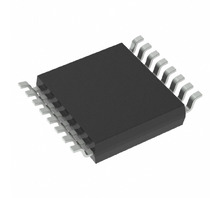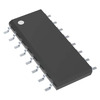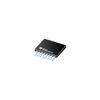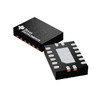Manufacturer Part Number
SN74HCS139QPWRQ1
Manufacturer
Texas Instruments
Introduction
The SN74HCS139QPWRQ1 is a dual 2-line to 4-line decoder/demultiplexer designed for automotive applications and optimized for low power consumption.
Product Features and Performance
Automotive Grade with AEC-Q100 qualification
Dual independent 2:4 decoder/demultiplexer circuits
Designed for low power operation
Compatible with 2V to 6V supply voltages
Adequate output drive with 7.8mA on both high and low states
Wide operating temperature range from -40°C to 125°C
Product Advantages
Operational in extreme automotive temperature environments
Reliable performance with automotive industry compliance
Suitable for various power environments with flexible voltage requirements
Compact 16-TSSOP package for space-sensitive applications
Key Technical Parameters
Type: Decoder/Demultiplexer
Circuit: 1 x 2:4
Independent Circuits: 2
Current Output High, Low: 7.8mA
Voltage Supply: 2V ~ 6V
Operating Temperature: -40°C ~ 125°C
Quality and Safety Features
Conforms to AEC-Q100 standards for automotive quality
Rigorous testing for automotive industry suitability
Compatibility
Compatible with 2V to 6V supply range
Interfacing compatibility with single-supply CMOS, TTL logic levels
Application Areas
Automotive control systems
Signal routing and multiplexing in complex electronic systems
Industrial and automotive logic level translation
High-density electronic applications
Product Lifecycle
Active product status
Long lifecycle typical of automotive-grade components
Not reported to be nearing discontinuation at the time of knowledge cutoff
Potential future replacement or upgrade paths as technology evolves
Several Key Reasons to Choose This Product
Automotive-grade reliability and compliance with quality standards
Dual function integrated into one chip provides space and cost-saving
Wide operating temperature range fits diverse extreme environmental conditions
The product is actively supplied and supported by Texas Instruments
Versatile voltage compatibility simplifies system power design considerations




 SN74HCS125QPWRQ1Texas InstrumentsIC BUFFER NON-INVERT 6V 14TSSOP
SN74HCS125QPWRQ1Texas InstrumentsIC BUFFER NON-INVERT 6V 14TSSOP SN74HCS138DRTexas Instruments
SN74HCS138DRTexas Instruments SN74HCS14BQARTexas InstrumentsHEX INVERTER WITH SCHMITT-TRIGGE
SN74HCS14BQARTexas InstrumentsHEX INVERTER WITH SCHMITT-TRIGGE SN74HCS14QDYYRQ1Texas InstrumentsAUTOMOTIVE 6-CH, 2-V TO 6-V LOW
SN74HCS14QDYYRQ1Texas InstrumentsAUTOMOTIVE 6-CH, 2-V TO 6-V LOW SN74HCS151QWBQBRQ1Texas InstrumentsAUTOMOTIVE 8-TO-1 MULTIPLEXER WI
SN74HCS151QWBQBRQ1Texas InstrumentsAUTOMOTIVE 8-TO-1 MULTIPLEXER WI